It must have been a comfort to successive heads of BBC Records to see another sound effects record in the release schedule. These albums of noises were never meant to make a splash in the charts or even get mentioned in the trades, let alone the music press, but they were solid business for the label. After dipping their toe in with No.1 (RED 47) in 1969 and No.2 (RED 76) in 1970, they really went for it with numbers 3 to 6 in quick succession through 1971 (REDs 102, 104, 105, 106). By the end of 1972 the original run of nine generically sleeved releases was complete and with No.10 (RED 120) – aimed specifically at home movie buffs – sound effects made up over 6% of all the labels’ 160-odd releases (excluding Roundabout and Study Series). From there, things slowed a little, but each new record in the series would now have a unique sleeve. In 1975 No.11 – ‘Off-Beat’ – (REC 198) was the only SFX record for two years. Another run of sound effects releases began in 1976 though and the numbering started wandering about a bit. The 13th instalment was clearly assigned for something in particular though…

Contents
This is a journey into sound effects
Why were BBC Enterprises even releasing sound effects records? Firstly the BBC had a trove of top-notch effects. Record compiler Rosemary Davies wrote on the sleeve notes of No.1 that is was acknowledged as the most comprehensive in the world, comprised of some 6000 sounds. With this supply of practically free material, the other as yet untapped side of the business equation was the demand. Sound effects records were nothing new. In 1958 Decca released ‘A Journey Into Stereo Sound’ featuring both music and field recordings demonstrating the exciting new possibilities of sound from two speakers, and providing an authoritative introduction for cut and paste DJ producers to sample 30 years later. In the same year, EMI put out the less flashy ‘Stereophonic Recording Demonstration Test Record’ with a similar remit, but foregrounding the effects on the A-side with such scintillating audio as table-tennis, road drills and swimming baths. Stereo demonstration records continued practically as a genre of their own well into the 70s, but they dropped the field recordings and focussed on the kind of sounds people would actually listen to on their new stereo Hi-Fis – music.
Across the pond, the Audio Fidelity label started releasing a series of records in 1960 under the prosaic title ‘Sound Effects’. These volumes were chock full of every kind of noise, but seemed to have no purpose other than a sense of gee-whizz will you listen to this! Audio Fidelity’s eclectic collections were in competition with one of the giants of the record industry. Jac Holtzman founded the mighty Elektra records in 1950 and in 1960 started a series of sound effects records. He personally oversaw the ‘Authentic Sound Effects’ records and these were also licensed to the PYE Golden Guinea label in the UK. On the US Elektra releases a service is offered for sequencing effects into a tape to your specification. This was offered to “non-commercial users” and “theatre groups” and there is a stern warning against making your own tape. The purpose of these sound effects seemed clear, but the practical application was being limited by that old chestnut copyright law. Assuming anyone paid attention to the small print, of course! All of these seem to owe their existence to the pioneering Cook record label. Cook was set up in 1952 by Emory Cook and set new standards for the quality of the recordings. Quick to capitalise on the possibilities of tape recording, one of Cook’s earliest releases was ‘Rail Dynamics’. This field recording was not only an early, perhaps the earliest, record for train buffs, it was also incredibly exciting for audiophiles. It seems that mere music was not the ultimate demonstration of a hi-fi system – performances being artifice – and a field recording was what was getting these geeks into a lather.
The BBC didn’t have a record label till 1967, so British sounds weren’t available to the record-buying public for another 10 years or so. When the BBC Radio Enterprises imprint started ideas must have been floated about all the possible sources of exploitation within the corporation. The sound effects record genre was well established and in the same year EMI had started a ‘Sound Effect Record’ series (another determinedly descriptive name!) and they were allowing legal use for all amateur dramatic and private films. Around the same time, the Soundstage label started issuing 7″ singles with specific themes, such as weather or sirens. As noted above, the BBC had sound effects in abundance and if it was working for EMI and the material was already on hand, why shouldn’t the new label have a go as well? Well, this might have caused a bit of (British*) tutting over at EMI! Or, they may have already lost interest in the genre, because they didn’t continue with their series and the field (no pun intended) was more or less clear for the BBC to monopolise from then on. The ‘BBC Sound Effects record’ became the de facto example of this genre.
*British Tutting was issued as a sound effects record by the BBC; alas only available in the town of Scarfolk.

In common with the other effects records series, the first few BBC Sound Effects releases were a gallimaufry of noise-making things and atmospheres. No.3 was big on watercraft, but not exclusively. Then, from part No.4 onwards, each record was themed. Although the basic sleeve design stayed the same, each now focussed on a particular subject so that you could choose from two sides of effects perfectly suited to your am’ dram’ production. These were:
No.4 – Victorian Atmosphere
No.5 – Road Transport
No. 6 – Town and Countryside
The BBC records were being marketed directly to the theatre world, as this advertisement in Drama magazine shows.

n.b. Samuel French publishes plays, so that’s where you go to get scripts.
All the first six discs were presented in mono, which seems surprising given the stereo effects in the market already, but from no.7 BBC Records decided that it was time for the switch to stereo. That meant going back to the classic variety pack of sounds, although no.7 (RED 113) was quite transport-heavy. No.8 (RED 126) went back to the thematic approach with Warfare and No.9 (RED 164) was the final part compiled (and edited) by Rosemary Davies as well as the last of the iconic grid sleeve design.
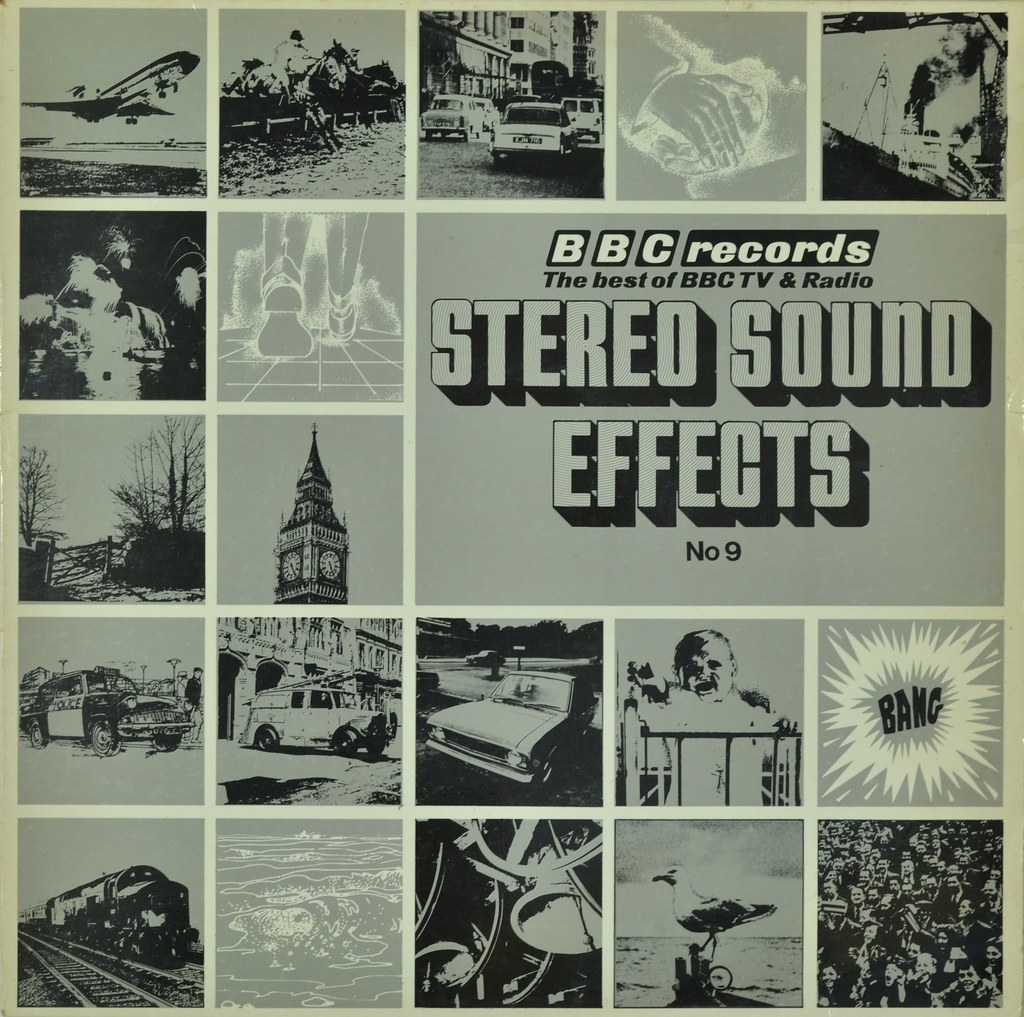
With the exception of the double-album gatefold-sleeved ‘Essential Sound Effects’ (REFX 448, 1982) each record would now have a specific theme and its own sleeve design. No.10 was put out un-numbered before No.9 and later retconned into the sequence. ‘Music & Effects For Home Movies’ was actually more specific in its intended purpose with a selection of vacation-appropriate foreign hubbub and music. Perfect, assuming your movies are indeed holiday reels and you go to one of the places included (bad luck if you went to Bolivia or you stayed at, er, home (hello from the CV-19 era!).
Another special interest the BBC as a whole was supporting was home animation. Many will remember fondly Screen Test with its annual animation competition and fewer will recall ‘The DIY Animation Show’, from 1974. This clip from the BBC Archive features a selection from the BBC Sound Effects series introduced by Ron Geesin. He mentions the “splendid range available on BBC discs” although he’s there to show you how to make your own. And doesn’t he just! A masterclass.
Sound Effects No.10 was produced by the BBC Radiophonic Workshop’s Brian Hodgson, for some reason, and No.11’s comedic ‘Off Beat’ selection was put together by Roy Maynard. The idea now seemed to be to find a theme and someone available to produce it on an ad hoc basis. They also apparently started to lose count as ‘Off Beat Sound Effects’ was again left un-sequenced. Retrospectively, the order of releases and catalogue numbers and sequence in the series was all over the shop and they seem to have become confused themselves. They were also starting to branch out beyond the core demographic of community theatre and Super-8 or Bolex owners. ‘Off Beat’, with its smashing lightbulb photo sleeve and wacky “F/X” was clearly of interest to kids of all ages, as was the next instalment!
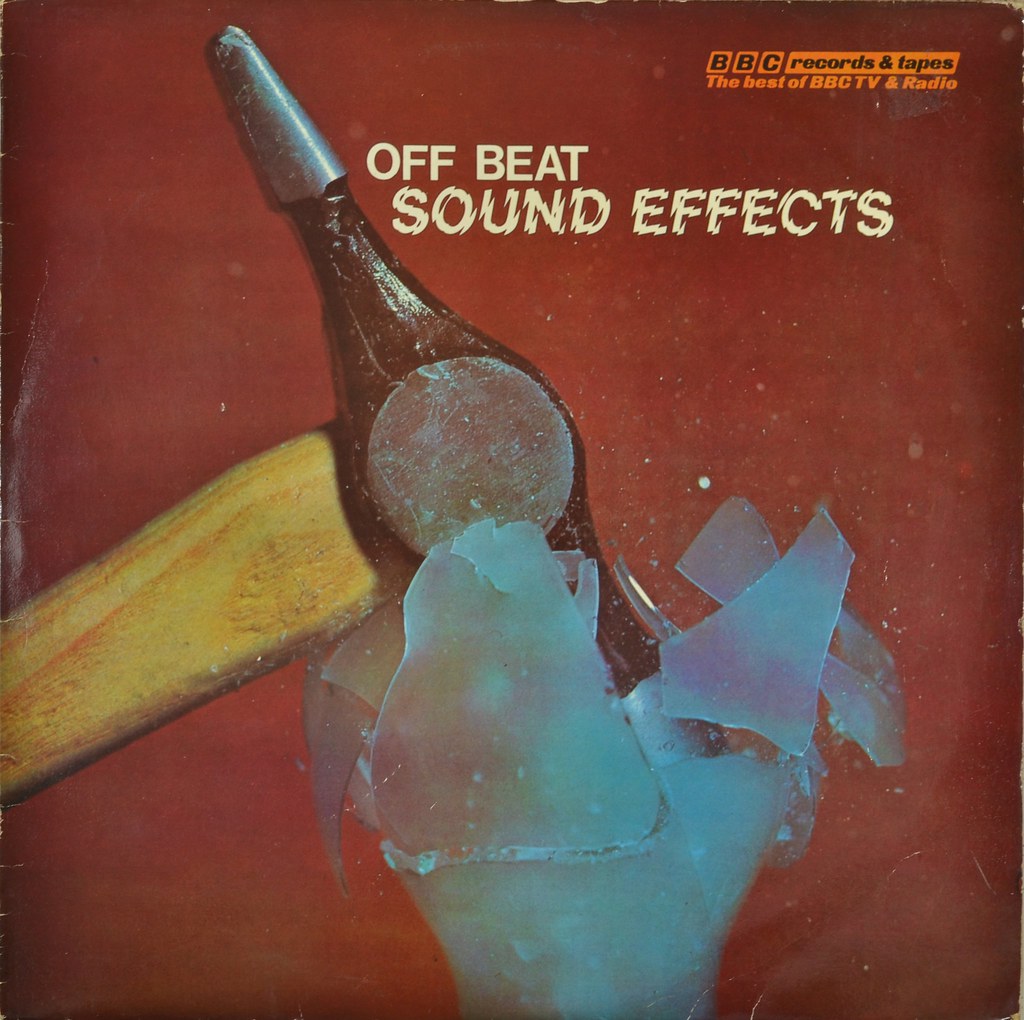
Strictly speaking, the following BBC Sound Effects release was no.14 (REC 220), but as I just made clear, this sequence is a mess, so I’m going by the series numbers and it’s no.12 (REC 225) next. That release was again not advertising its true place in the series (can you tell this is annoying me?) but ‘Out Of This World – Atmospheric Sound And Effects From The BBC Radiophonic Workshop’ was also appealing to amateur sound editors and a wider record-buying market, although we are by definition now a very long way from… umm, let’s say ‘Laughter – Hearty, 30 People’. The Workshop’s Glynis Jones produced an all-star Radiophonic line-up and this was the first time the ‘special sound’ that had been created at this unique facility had been made available. Two albums of Radiophonic music were available by this point, but sci-fi and fantasy fans – starved of much to see them through between never-to-be-repeated (sadly, quite literally in some cases) Doctor Who series – were sure to be picking this up along with whatever comics and magazine catered to what wasn’t at the time called ‘fandom’. More than a few electronic music enthusiasts would have been happy to get hold of anything as cutting edge as this too. I’m not saying there was no call for these sound effects in practical applications, but tracks like ‘Time warp start, run, stop’, ‘Goblin’s lair’, ‘Firespitting monster’ etc. and that sleeve design could not escape the attention of record token totting teenagers either. As the American Cook label had issued a record of the same name in 1953 I wonder if this was a kind of sly nod to their forebears. As it wasn’t released in the UK and was 23 years old by then, I doubt it.

All that is to say, when BBC Sound Effects Vol.13 Death & Horror (REC 269) was released there was already a wide market for sound effects LPs sustained and developed by BBC Records. Not only was this edition of the series numbered with the unlucky 13 (the chance to taunt any triskaidekaphobics too good to pass up) it continued the programme of themed effects produced by a new pair of hands and a striking sleeve design. It was also only one of two parts of the SFX series to be called a volume and not a number. The haphazard numbering was just not confusing enough and inconsistent naming was also needed! Anyway, following on from a comedy and a sci-fi-fantasy record, horror was a natural choice when going for a young market, right?
Horror movies were at a creative and commercial peak in 1970s Britain and television was in on the action too with a succession of notably creepy and scary children’s dramas. Halloween wasn’t anything like the big deal that it has become from younger children now, but back then high school kids were being subjected to a campaign of terrifying culture never seen before or since.
Doctor Who was going through a particularly gothic patch in 1976-77 too. Plucking keywords from the story titles we have: Fear, Deadly, Evil, Death and Talons. A genre that had hitherto been an adults-only, late-night, X-rated thrill and was now primetime Saturday teatime fare was a canny choice for a sound effects record. Because all the theatres and film-makers were tapping into this zeitgeist too, of course.
Mike Check
Death & Horror was produced by label stalwart Mike Harding, a seasoned producer who worked on many diverse records for the label from 1973 onwards. Unfortunately, in various writings on BBC Records and Death & Horror, he is most often misidentified. Even when they don’t credit the wrong person entirely his role is misunderstood or he is assumed to be something at the Radiophonic Workshop. I don’t have anything near a complete biography for him but I can at least put most of the relevant and correct details here. He is a soft-spoken Scot and is assuredly not the other Mike Harding from Lancashire with a funny tale and a song or two. The Rochdale Cowboy is another person entirely.
Prior to being a BBC record producer, this Mike Harding was a late-night Radio 1 presenter, introducing ‘Sounds of the Seventies’ one night a week. Mike sneaked onto the Old Grey Whistle Test in 1972 as part of a scratch BBC rock-n-roll group ‘Pete Drummond & The VHF Band’ (geddit?) celebrating 50 years of the corporation. The record – ‘Rocking at the BBC’ – was released by Warners (for shame BBC Records!) with Mike on lead guitar (of course, this was the man who had a guitar solo slot on his show) alongside Paddy Kingsland (by now at the Radiophonic Workshop, but formerly a studio manager at R1) on bass.

By 1972, Harding was introducing ‘In Concert’ on Radio 1 and from there he made the move to the BBC’s record label. Whether this had anything to do with all the concerts that were cut to BBC Transcription Discs I can’t say. In 1977 he was part of another BBC band, this time celebrating the ten year anniversary of Radio 1. ‘Radio Active’, as they were called, appeared on the BBC Records spin-off pop label Beeb with ‘Ten Years After b/w Alltime Needletime Loser’. A b-side which neatly combined the Musicians’ Union rules on the amount of recorded versus live music to be played on the radio with the vagueries of the rock music business and getting a good education. Or some reference to heroin use amongst punks perhaps?
Anyway, Mike Harding is also credited with devising Death & Horror, his first sound effects LP. That means he was not simply called in to see an idea through to manufacture, it was apparently his brainchild. Quite appropriate for an axe-wielder!
Scream Team
Mike Harding was assisted by studio managers Ian Richardson and Lisa Braun; the Radiophonic Workshop’s own sound effects maestro Dick Mills and there was also a contribution from BBC Records wildlife favourite, Eric Simms.
Simms had turned in 11 out of 13 parts in the BBC Records’ Wildlife Series. These collections of sounds from animals and birds preceded the sound effects series, starting in 1969. Simms would produce his own sound effects record. No.17, ‘Birds and Other Sounds of the Countryside’ (REC 299), in the same year as Vol.13, but BBC Records had really covered a lot of the living world with the Wildlife series so anyone needing the calls of the Black-throated diver or a ‘Hungry Lion (London Zoo, 1938) was well catered for. For sound effects Vol.13, he provided recordings of (naturally (pun intended!)) bats.
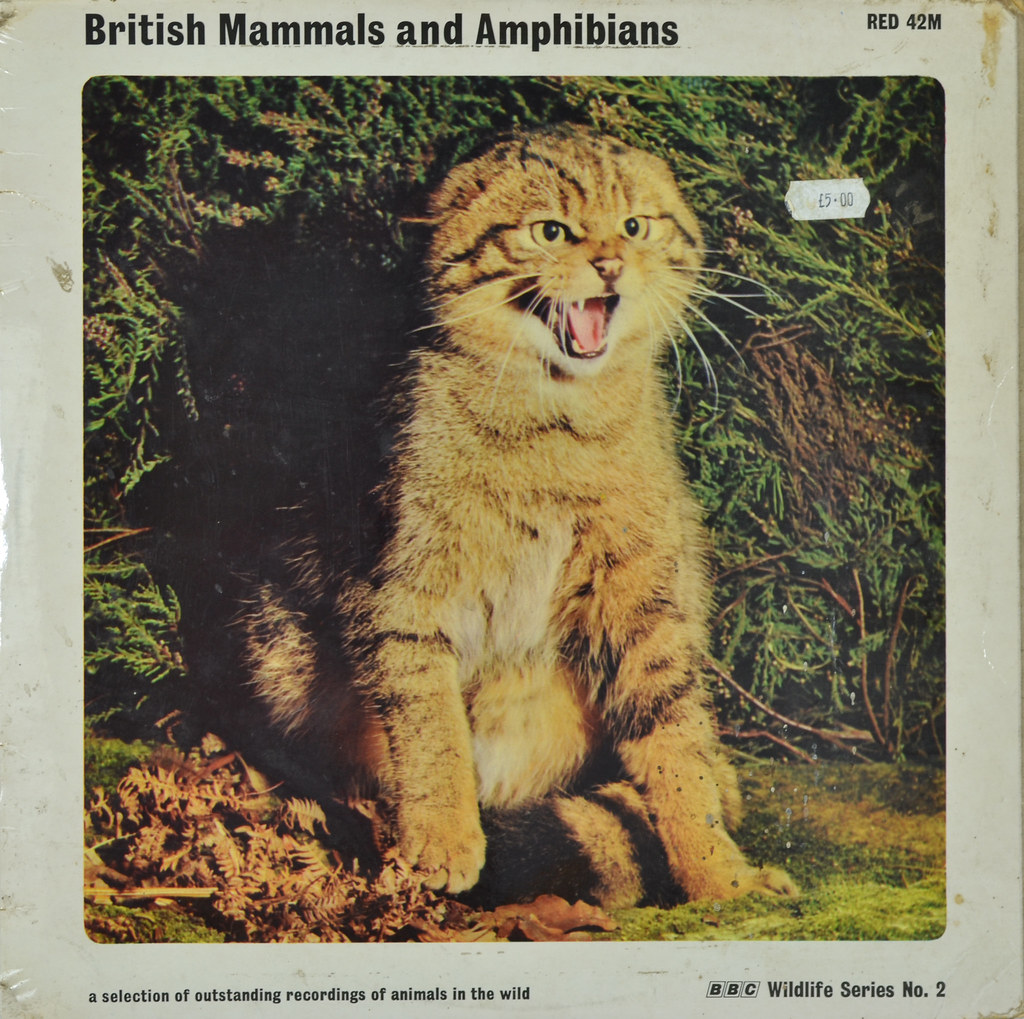
Back in the comfort of the BBC’s radio facilities, the Studio Managers Ian Richard and Lisa Braun were handling anything not already on tape. Both were radio staff and Braun later went to work on The Hitchhiker’s Guide To The Galaxy – where she met her future husband, the late great Geoffrey Perkins. Richardson had already popped up on BBC Records in 1974 as part of the “technical team” for the radio version of Dad’s Army. As the radio producer John Dyas notes, that lot “soaked themselves in gallons of water, squelched, marched and drilled incessantly around the studio floor, opened doors, fired guns and provided every sound effect the Walmington-on-Sea platoon could ever need”. The home front seems to have been the perfect preparation for Death & Horror then, and that LP was produced by (of course) Mike Harding. Richardson later moved on to freelance television and film sound recording work and ended up winning a Welsh Bafta for his work on the revived Doctor Who. At least, I think that is the same Ian Richardson. Along with Mike Harding and Roy Tempest, mistaken identities seem to haunt BBC Records.
Satanic Mills
Dick Mills’ CV will be covered more extensively elsewhere on this blog; suffice to say that he was a veteran of putting the willies up BBC listeners and viewers, having been around for the early days of the Radiophonic Workshop’s Special Sound era of radio drama nightmares and mental breakdowns. He assisted Delia Derbyshire on the original Doctor Who theme and became the show’s sound-effects maestro when Brian Hodgson left in 1972.
Dick was asked about the D&H LP in an interview with Dutch radio station KRO in 1981.
“It was BBC Records’ idea, but when we found out that they were doing Death & Horror sound effects records we said ‘would you be interested in any of our sounds that we’ve already done for Doctor Who? Giant spiders; mad scientists laboratory, The Phantom of the Rue Morgue – the organ playing – and things like this’. And our contribution to that record is types of sounds that couldn’t have been produced in the normal sounds effects way.”
Rauhfaser – Brom en Ruis – afl 162/1v2 – ‘Radiophonic Workshop BBC’ – 7 jan 1981
When it was put to Dick that you’ve “got to have a bit of a morbid mind, to think out things like that” he quipped “not with some of the people I work with!”.
“If you’re in a creative department, and you don’t know what you’re going to be asked to do, you’ve got to be able to visualise any situation; any dramatic situation”.
Rauhfaser – Brom en Ruis – afl 162/1v2 – ‘Radiophonic Workshop BBC’ – 7 jan 1981
A crack team then. What did they come up with?
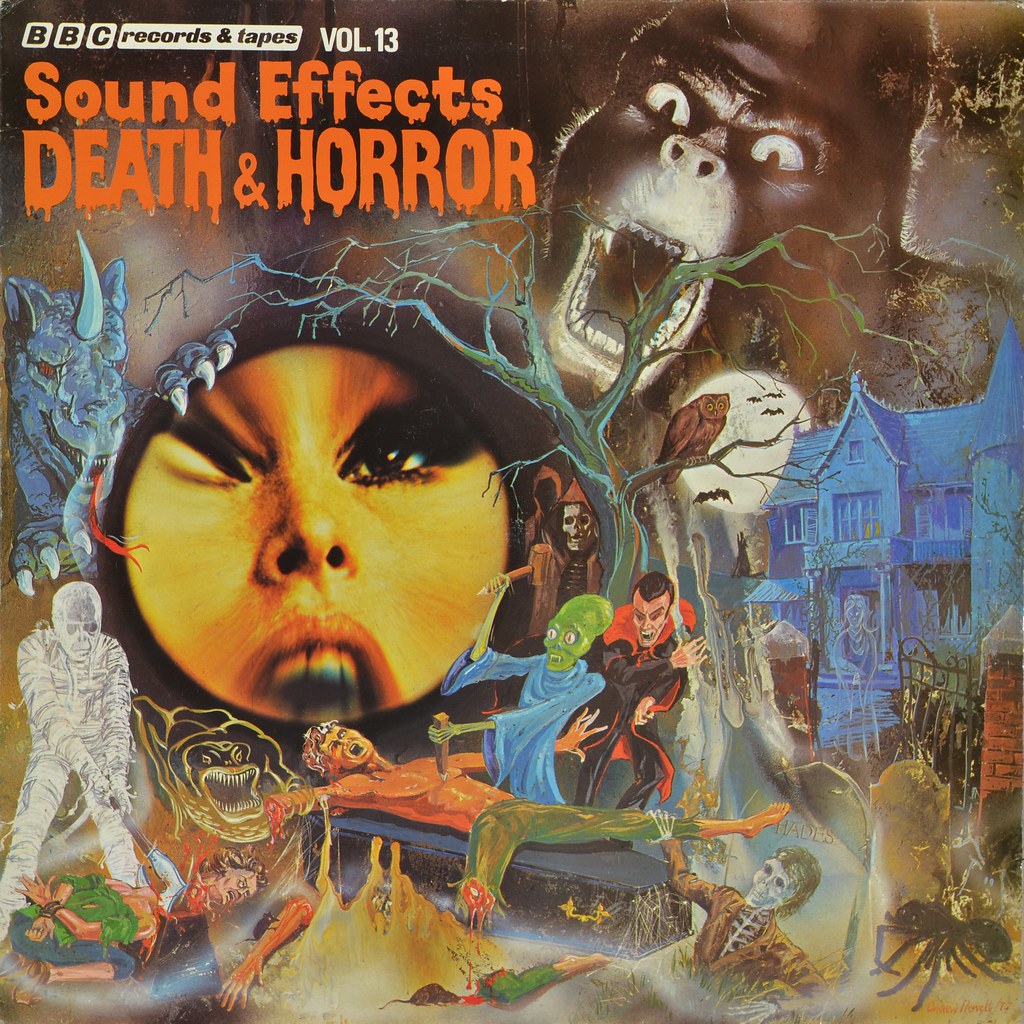
‘Art Attack
Well, before you even hear what terrors are in store there is a visual assault in the form of the record sleeve to negotiate. I mean actually negotiate with an adult if you were underage. It is quite conceivable that more than a few kids had the LP snatched from their grasp and replaced in the racks by concerned parents. As lurid a montage of death and horror as anyone could imagine in a fevered state of possibly drug-induced psychosis. Hyperbole? Well, the sheer number of bizarre, shocking and unpleasant things going on is tempered only by the cartoonish painting style. The most disturbing part might be the woman’s screaming face contorted in a circular mirror at the centre. Is she dreaming of the surrounding nightmare? Is she seeing it through some sort of portal into hell? It doesn’t matter. It’s brilliantly horrid. Gross and silly. Weird but patently untrue. I can only imagine that Mike Harding told designer and illustrator Andrew Prewett to go all the way and keep going. The more extreme the better. One reason it’s so over-the-top is the idea of including everything that’s on the record in the image. The older pop-art sleeves got this right by showing that there was a potpourri of noises contained within. Death & Horror’s sleeve gleefully presents a tableau of total carnage and fear. You were warned! Or invited in, if you dared.
Happily, Prewett’s reminiscences are recorded on his blog
I decided that a graphic illustration was need to enhance the product that had up to then been sent out on tapes and some in plain record sleeves. So I set about illustrating some of the content in a gory way, (tame by modern standards but this was 1978). It was an amazing success and took us all by surprise, some press featured it and the then self- appointed guardian of British morals sent a very strongly worded letter to me suggesting that I was corrupting the minds of young people with evil images. Sad to say it only fuelled the sales and further records followed, some with more of my illustrations and designs
https://www.andrewprewett.uk/2011/10/more-death-and-horror.html
Oh yes, D&H was controversial in some quarters as we’ll see.
Breaks, Beatings and Scratches
Execution Style
Side 1, Band 1 gets straight down to diabolical business. As the record title promised death and horror, it’s called Execution & Torture and makes no apologies. Limbs are chopped, broken and sawed; stakes are hammered in or burned; very hot things applied to flesh and projectiles find their mark. Although, the arrows only hit wood, which seems a bit off target here. Finally – Oh no! Not… – ‘The Pendulum! Umm. What? Yeah, I had to check this one, but it was more of a swinging axe that got closer and closer. This one is probably the work of Dick Mills. He would have made short work of this (modulated filtered white-noise) with the EMS VCS3 synthesizer, a machine dedicated to making simply sounds rather than music. As Ian Richardson explains on the sleeve notes the harmless white cabbage stands in for human bodies and gets all the abuse that the medieval torturers could dream up. Chopping stabbing and even the sizzle of red-hot pokers are courtesy of the brassicas. If you’ve seen the excellent Peter Strickland film Berberian Sound Studio starring Toby Jones as an effects man working on a gory Italian ‘Giallo’ flick, this will come as no surprise. And if you haven’t, you are encouraged to seek it out.

Richardson says that most of the effects are from the BBC library or Radiophonic Workshop, but as well as the details of cabbage mistreatment he describes one other effect in detail. “The Guillotine was a heavy metal bar sliding down a coat rack edited to a cabbage chopped into a basket with straw inside”.
Monster Mash-up
Side 1, Band 2 lowers the heart-rate one notch with mere implied peril and threat from Monsters & Animals. All the gang are here. Wolves and Werewolves, Hell hounds and the aforementioned Bats by Simms. Snakes get a couple of tracks and a generic Monster Roaring. The least concerning might be the cat hissing, although this could lead to a nasty scratch. Is Dracula a monster? I suppose so, which is why he’s here getting into a flap. Most famously the murderous menagerie is heralded by ‘The Mad Gorilla’. Not King Kong, no, another one. Setting aside the twin crimes of perpetuating myths about gorillas (see Fossey et al) and trivialising mental health issues, this is not a field recording. Eric Simms was apparently unable to supply such material, so it was back to the library or the recording studio. No, they didn’t get Guy the Gorilla from London Zoo into a rage they just got a bloke to pretend. Sometimes the real thing isn’t really what you want anyway. ‘The Mad Gorilla’ made it back to Hollywood and gave voice to Slimer in the original Ghostbusters (1984) movie.
I first learned of this in conversation with a chap working at Vinyl Resting Place in Manchester. On Twitter, @RealFloppyLion says he spotted this in the cinema at the time! He also caught a bit of ‘Electric Storm’ by John Baker from Out Of This World Sound Effects during the scene where the containment unit is switched off and all the ghosts escape. This anecdote really underlines that youngsters would listen to these LPs over and over till they could identify the effects in use even when they are non-specific swooshes or roaring.
Grave Dangers
Continuing the downwards trend in fearfulness Side 1, Band 3 is given over to Creaking Doors and Grave Digging. Thoughtfully, the latter is provided in both dry and wet ground (so annoying when that isn’t done right). Coffin lids are nailed shut and then (ahhh!) creak open again. Doors open and close ominously and a portcullis slams shut to end a handy selection of boring sounds elevated by their context into chilling portents.
Step In Time
And now for a musical interlude! The final band on Side 1 is split between Musical Effects and Footsteps. What separates musical effects from just music? Length, mostly. The first cue is called Phantom of the Opera. As this record pre-dates the Andrew Lloyd Weber behemoth by nearly ten years the reference here could be to either of the three film adaptations of the Gaston Leroux novel or even the lesser-known stage musical by Ken Hill, which was performed in Lancaster in 1976. Or even a nod to the Phantom of the Paradise movie. Actually, as Dick mentions above, perhaps this was originally from The Phantom/Murders in the Rue Morgue. In 1968 the BBC broadcast a TV dramatisation of the Edgar Allen Poe thriller The Murders In The Rue Morgue starring Edward Woodward. This Verity Lambert produced programme was part of the Detective anthology series which ran from 1964 to 1969. Although there is no record of the Radiophonic Workshop providing anything for that episode, Dick did work on another edition of the series in the same year. In any case, these generic doomy notes are more redolent of horror movie soundtracks to my ears. The next two tracks are titled Ghostly Piano chords and those who know that the Radiophonic Workshop had a dismembered piano frame might wonder if Dick was using that here. Quite possibly, although several have definitely been played by functioning piano keys. After some gongs and chain clanking the first side comes to an end with Squelching Footsteps. It’s definitely squelchy, but footsteps don’t come immediately to mind. Dick Mills has talked of using the sound of Swarfega hand gel being squished about and then slowed down for some of his most satisfying sounds. This effect is clearly looped (a Radiophonic basic) so I’m going to call this one of his too. He may have already had it to hand (I’ll take that pun, cheers!) from a Doctor Who session.
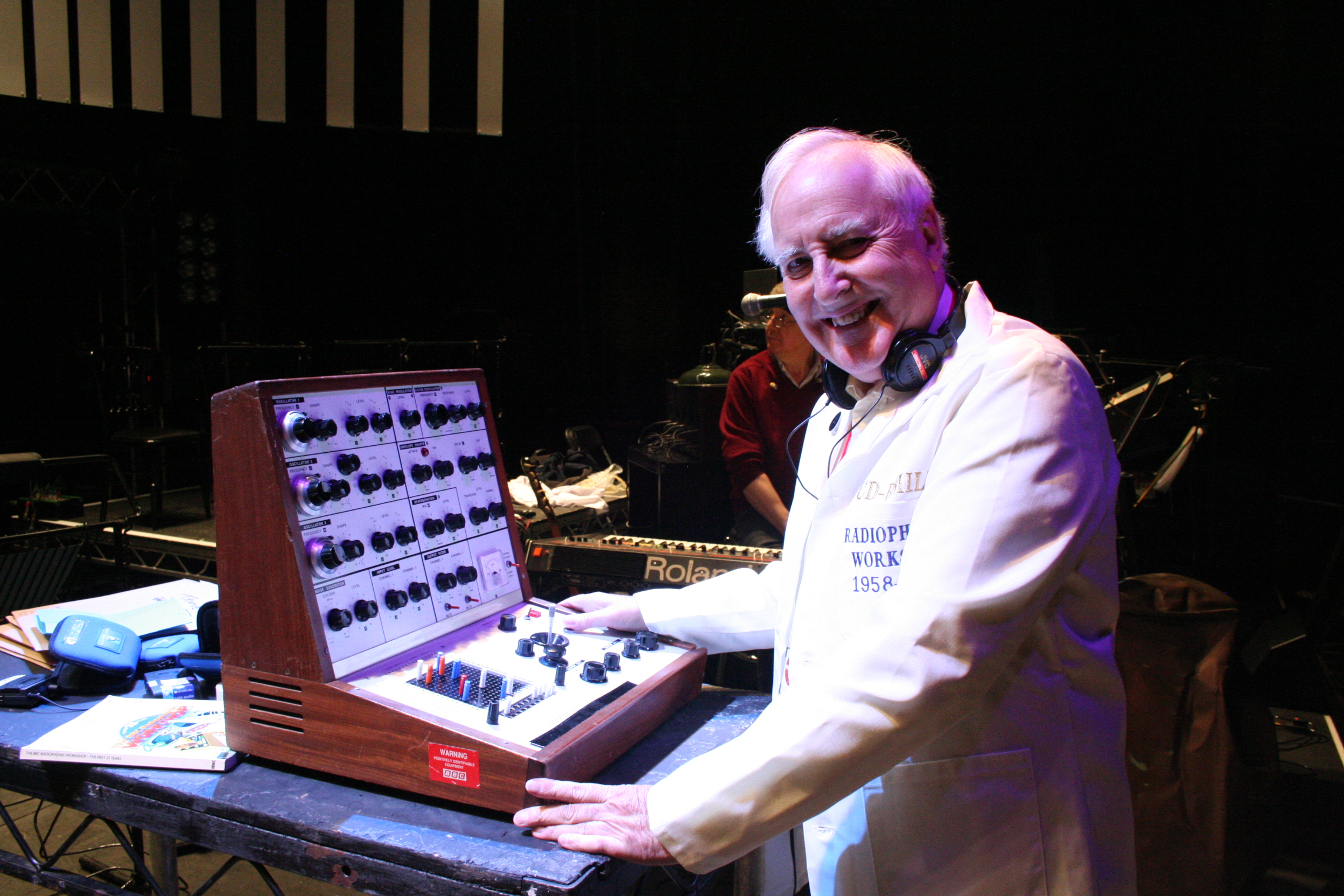
Scream Hearts
Side 2, Band 1 is dedicated to sounds created from within the human body whilst going through some sort of ordeal. That’s different to the Side 1 Band 1 sounds, which were notionally made by the human body whilst undergoing some external attack. It’s important to get these distinctions clear, I think. One strangulation followed by a whole lot of screaming, sobbing and breathing. I assume that these aspirations came from the BBC library, rather than being vocalised by Ian and Lisa themselves. Similarly ‘Lunatics Laughing’ (more dubious mental health attitudes of the time, I’m afraid) could be the pair of them, or something already available. Heartbeats of the human variety are followed by both Electronic and those of Frankenstein’s monster. The difference between these two is that the latter are doubled up. We can assume Dick Mills was behind all of these.
Thunderbolt and Lightning, Very Very Frightening
Side 2, Band 2 is titled Weather Atmospheres & Bells and is the final section of the disc. Bad weather of all kinds is laid on including both ‘Eerie’ and ‘Weird’ wind. Bells toll and more gusts are included, this time ‘Howling in Ship’s Rigging’. We start though with the thunder. One of the most famous (through over-use) sound effects of all time is ‘castle thunder which was created in 1931 for the film ‘Frankenstein’. You will hear that used in movies and TV shows right through to the 90s without irony, but is now generally deployed only for genre parodies and cartoons. The thunder here though is what I think of BBC thunder. The third clap in particular is the one. I read somewhere that this slightly implausible sound was used so much because it was better to use something that viewers and listeners instantly identified as thunder even if it wasn’t what that actually sounded like. That gorilla from earlier needs a setting and therefore we have ‘Jungle at Night’ and there’s a ‘Tropical Atmosphere’ to warm us up, after all, that perishing wind.
Release The Sounds!
BBC Sound Effects Vol.13 – Death & Horror was released early in 1977. An exact date is hard to come by, and some of the accounts seem muddled. Apparently, Roy Tempest left the label in 1976 and soon Alan Bilyard was conducting bevied up sailors on the Ark Royal in his new role as label boss. As we’ll see though, Tempest was still in charge in 1977. Whatever the release date, by the 23rd April Billboard magazine in the United States had picked up on a story. Under the headline ‘Horrible Sounds Lure Beautiful Sales Action’ they reported that BBC Records were shifting 100,000 records a week and had broken into the top 100 chart. It’s a measure of the size of the market in those days that such a large number of sales was only a top-100. Chart archives are only available for the top 60 now, and it didn’t make it that far. Nevertheless, 2-3 weeks of this ‘action’ would make for a gold disc! Label MD Roy Tempest told Billboard that, if it continued, D&H was on course to beat the all-time best seller. Which was? Another sound effects record!
The real interest in this news story though was the condemnation of the record from so-called moral guardians. Chief amongst them was, naturally, Mary Whitehouse. The head of the Viewers and Listeners Association may have been straying a little out of her remit though. She accused the BBC of having a “sense of utter irresponsibility”, but as this was a record and not a broadcast she was mistaken in pursuing the line of argument that here was another example of that old saw the ‘waste of licence fee’. BBC Enterprises’ commercial exploitation of existing material paid for itself, as did any additional production work. It only takes a moment to realise that these LPs were not being given away to licence fee payers!
Whitehouse’s criticism of their “lack of responsibility” was the only charge worth answering. Tempest had this defence:
“It is important to point out that this the latest in a series of sound-effects albums we are putting out for a specific market of amateur dramatics and home movie people.
Billboard Magazine 23rd April 1977
It is not something just put out for a laugh. We had many requests for errie and horrific effects for stage thrillers.”
Hmm! Well, I have to point out that it was also “put out for a laugh”, wasn’t it? I mean, they knew it was going to have reached buys beyond the stage and screen amateur. As I already pointed out above, there was a market for sound effects records amongst kids and they must have known it. A more honest answer would have been that they were going for a crowd of younger people too, but weren’t responsible for other people’s children and the sleeve design made it very clear what was going on. Do I also need to point out that you don’t sell 100k units per week to drama clubs and budding John Carpenters? Despite the protestations of innocence and boasts of gold-disc selling figures, them upstairs were initially rattled by the uproar. Recalling the events for the BBC Music website, Alan Bilyard relates what happened when the Beeb took fright at its own record:
“We had to suspend the record, but ultimately I got approval to put it back on the market and it sold about 20,000 copies due to her.”
As they were selling 100,000 a week it’s unclear how that 20,000 was calculated. Perhaps they estimated that was the boost that Mary Whitehouse had given them.
Hi-Fi Weekly Demo
As noted in Billboard, the 2nd April 1977 edition of Hi-Fi Weekly presented a free 7″ single with excerpts from Death & Horror. This disc was “exclusively produced with the co-operation of the (sic) BBC Records & Tapes” and contained “Hi-Fi Weekly’s Choice of Humour Effects”. Well, at least they thought it was a laugh, eh Roy? These were “Selected from the BBC Sound Effects Catalogue of albums which includes the latest ‘Sound Effects Vol.13 Death & Horror’. All the hits are here: ‘Mad Gorilla’, ‘The Guillotine’ and ‘Arm Chopped Off’ and a few from numbers 10 and 12 too. I hardly need to point out that this was marketing the sound effects series to the wider record-buying public.
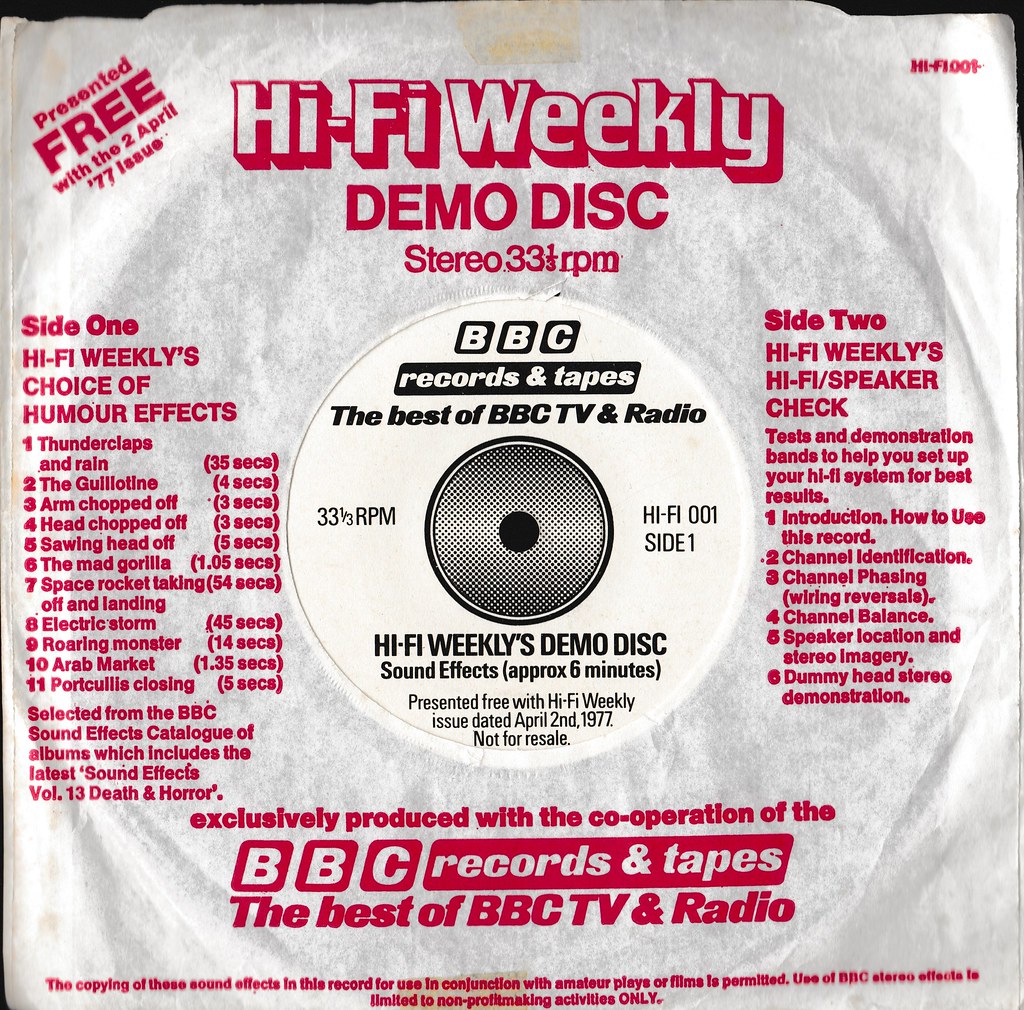
You will have noticed that I’m giving Roy Tempest a hard time about his comments to Billboard. The reality was that Mary Whitehouse was an absolute pest and the BBC her favourite target. Her attack on the commercial aspect of the release was off the mark and easy to deflect. The censorious moralising – “won’t someone please think of the children” – was, I think, harder to ignore. In some ways, the pop culture of frightful gothic chills was slightly getting out of hand. It would take a few more years, but either because the fashion changed or they just got the message that kids were sick and tired of being creeped out or scared witless, things were calmed down. That doesn’t mean Whitehouse was right either.
A Japanese Werewolf from London
Death & Horror was released in North America, Germany, Australia and New Zealand in 1977. These were fairly straight reissues with the same sleeve design except for an updated record company logo. In the early 80s Spanish label Diapason started issuing the Efectos Di Sonido series and in 1982, amongst half a dozen of the BBC’s LPs, volume 13 appeared with a slightly doctored sleeve design under the simpler title of Horror. The year after release Teichiku Records Co. of Japan put out a few BBC Sound Effects records and for Death & Horror decided the original phantasmagorical sleeve was either too much or maybe not enough?

To be fair, they identified the one monster not depicted in the original and made the missing werewolf centre stage in their slightly calmer if no less (pseudo?) naive style tableau. The lycanthrope is joined by a tired-looking vampire and pensive Frankenstein’s monster, but he’s drawing most of the attention with a goblet of blood a good proportion of which has dribbled (or spilt) onto his arm. What a mucky pup!
If there was any moral outrage in the export markets I’m not aware of it. In fact, in America sales were still going strong years later thanks to adverts like this one in Fangoria magazine. Clearly, not having “a laugh” though.

More & (Even) More!
The horror genre loves a sequel and as you can see from the advert above, Death & Horror’s success led to two (erm) more compilations.
More Death & Horror was released in the year after the original and took its place as number 21 in BBC Records & Tapes continuing series of very serious sound effects LPs. Not that there were eight more released between 13 and 21 – numbers 14 and 15 had been issued in 1976 – but the labels were very busy with SFX discs. Disasters took the 16 spot with a similarly terror-related theme; 17 was given over to birds and wildlife; 18 Holidays; 19 Doctor Who and 20 Sporting Sound Effects. An eclectic array of audio material, but they were baying for more blood. So much so that for some of the pressings the very vinyl itself was red with it. Not just cheap vinyl that glows red when held up to the light either. This was blood-red coloured vinyl with a silver hype sticker on the sleeve to draw your attention to it. Whitehouse be damned, it seems.
Mike Harding was still in charge and takes over the sleeve notes, introducing his accomplices and explaining that each band is presented as “little montages”. The effects were this time all created for the record, so no gems were proffered by the Radiophonic Workshop or genuine wild animals. The second half of the sleeve notes come from Peter Harwood who along with Paul Hawdon and Anne Hunt was responsible for the sounds. I’m pleased to know they used a Neve 24-channel:4 group mixing desk (to create sound effects that were not even all in stereo) and the teapot used for one sound was a “BBC teapot”, but the rest of the techniques are not that amazing after the original revelations about cabbages.
The sleeve is another depiction of a wild night, taking in a returning Dracula with a distraught maiden in his clutches who, it can’t be ignored, has had a clothing malfunction. Did the local rep and the film club at the village hall ask for that? Well, anyway, there’s torture in progress and what appears to be a throwback to the original 1958 version of The Fly (see track 1 side 1 ‘Death Of The Fly”), a witch(?) and I’m going to say a lizard monster.

If anything, More’ D & H ups the ante with some scenes that go beyond Halloween chills and supernatural spookiness and into just unpleasant and some that definitely wouldn’t pass these days. It’s a mixed bag though and a ticking bomb and some wind are a bit more, if not fun, at least lighter in tone. In the end, what comes across is More Death. And horror.
The first edition of Death & Horror remained available in the catalogue for many years, yet this one was only popular enough in Spain to keep going till 1990. Still, it seems to have sold well enough in 1978 to keep the second-hand market afloat to this day. The Japanese market got this one too, probably at the same time as the original, but kept the same sleeve design. They did add that all-important obi strip though, with mad eyes motif and some poor soul drowning in a swamp (side 2, track 1).
Even More Death & Horror
Sound effects releases continued for the next four years albeit at a slower rate. 22 was actually music, for silent movies; 23 is essentially an ambient music album from the RWS called Relaxing Sound Effects and was the other volume, not number; 24 was a bit more compelling for fans of D&H being all sorts of Combat sounds; 25 was the sounds of speed (vehicles, you understand) and Essential Sound Effects was a compilation and didn’t take a number. And then, some four years since the previous one, it was high time for another disc of Death and Horror. This time prefixed as ‘Even More’, Mike Harding and Peter Harwood were still presiding with an expanded team of Studio Managers and the return of the RWS. It may be that these effects were all from the library and not created specifically for the record. The selection of effects were covering familiar territory with the same regrettable, not really fit for humour stuff in the ‘Intentional Death’ section contrasting with more innocent thrills of a sleeping dragon.
The sleeve design is a break from the previous visual assaults with acrylics. Instead, we get a photo vignette of a record (which can’t be this one because BBC records always have a strict text-only label design policy) that a monster is placing a needle on. Nice meta touch! When you realise that the silent era woman pictured on the label is screaming at the clawed hand, it’s all clearly been very well thought out. The headshell is a rather unusual design and the rest of the record deck is not in evidence, so what ought to be obvious is a little obscured, but hey, it works!
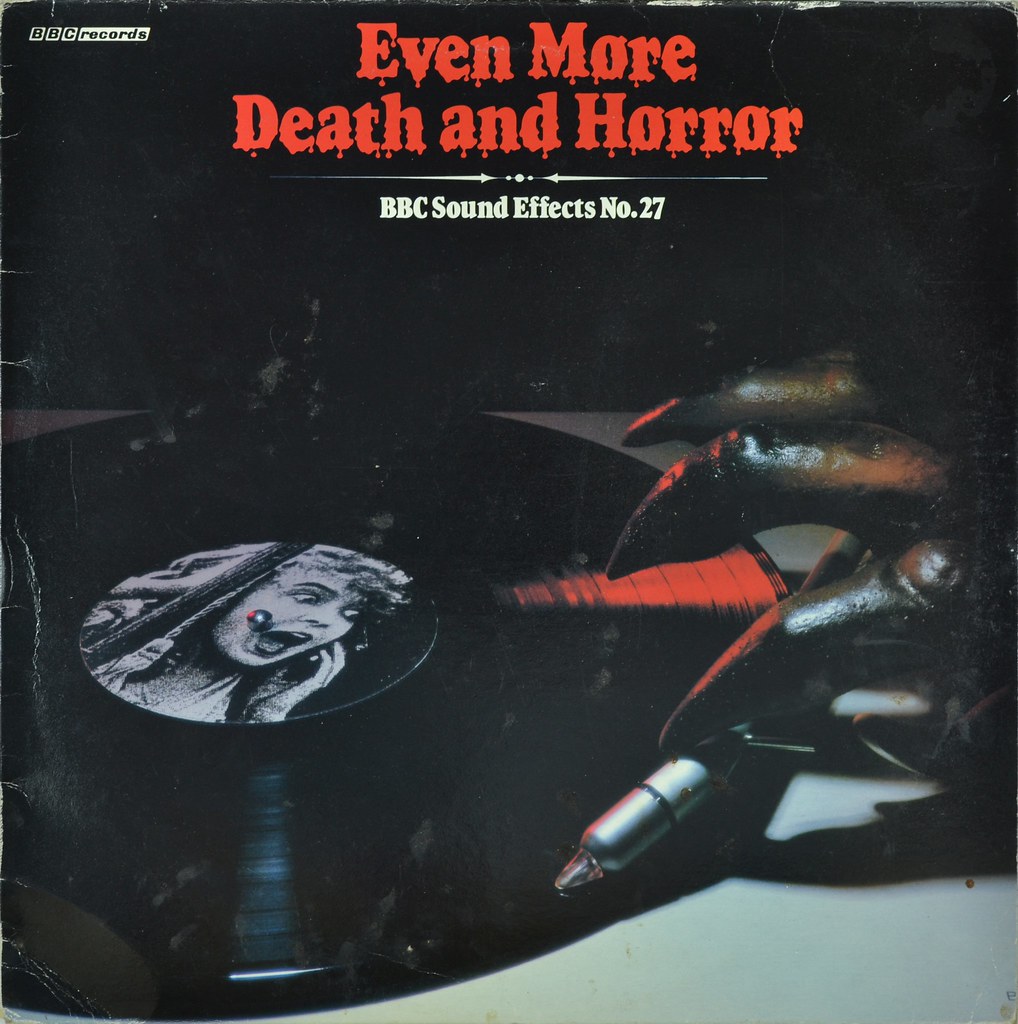
There we only two more original selections of sound effects pressed on vinyl by BBC Records. Part 28 saw comedy making a very late entry for what seems an obvious choice of subject matter, although Off Beat makes a claim for that. And finally, the clunky push-button machinery of the early days was finally wheeled out be replaced by a whole LP of Hi Tech sound effects (But ssssh! Don’t tell everyone that this is another secret Radiophonic Workshop LP, with a whole side of music and ambient textures that stretch the sound effects template a little). That was it though… for now!
Essential Death & Horror
Vinyl’s death knell (Check which LP this is on. Ed.) was sounded around the start of the nineties and whether you prefer to think that it never died or became one of the undead, it was dropped as a format by BBC Enterprises. BBC Records were switching to mostly cassette-only audiobooks and radio shows (and wondering whether to switch names to BBC CDs and Tapes presumably). Although there was definitely less music being released it was more or less business as usual in the exploitation of the Beeb’s back-catalogue and the clamour for sound effects had not abated. Hence, most of the Sound Effects series was repackaged and recompiled as CD releases with new artwork. The catch-all title for this run was Essential and so Essential Death & Horror was released in 1990 in parts 1 and 2 – CD 822/823 – These were 87 (and 59) “terrifying treats from the BBC’s Sound Effects Library”.

Both parts had the same sleeve design sporting a simulacrum of the original horror show paintings in much tamer and more comic book style.
I’m not sure if these were ever deleted from the catalogue, but it says here that in 2010 BBC Audio Books changed names to AudioGo and in 2012 reissued Death & Horror with an updated booklet design and the same cover image. There was an additional tagline now too “Are you brave enough to listen”? As AudioGo ceased trading in 2013 the BBC’s reign of terror finally came to an end here after 36 years. Or did it??
Yet More Death & Horror
A few years before the general public got their hands on CD versions of D&H professional sound editors got access to digital sound effects from the BBC. This set of CDs was issued by BBC Records & Tapes who marketed them squarely at recording studios and the like. Initially a 10-CD set the full complement would set you back nearly £230 in 1987. In that first set was SFX 008 ‘Comedy, fantasy and horror’, which contained a smattering of familiar cues from the back catalogue.
In fact, this superseded the vast set of some 4000 7″ records from the BBC Sound Effects Centre. A complete catalogue of this jaw-dropping collection has not come my way, but I expect a lot of the effects found on the three Death and Horrors are on these two. It was these discs with generic labels and sleeves only that I believe Andrew Prewett was aiming to replace. A case of overkill, really.
Back from the dead
The normatively deterministic Demon Records saw to it that the hitherto unbroken run of availability for the BBCs horrific sound effects didn’t remain that way. Demon not only specialises in the reissue of back catalogue records but are now owned by BBC Studios, the current commercial operation of the corporation. In 2016 BBC Sound Effects Vol.13 Death & Horror was reissued by Demon on blood-splattered vinyl. Thanks to this new pressing D&H is still widely available and this undying classic from the BBC Records sound effects series is creeping out and delighting horror fans to this day, courtesy of the BBC itself. Like the recurring monsters and seemingly immortal bogeymen of the horror genre, these sound effects seem destined to keep coming back from the dead.
- https://moviesandmania.com/2014/07/27/death-horror-bbc-sound-effect-lps/
- https://www.discogs.com/No-Artist-Spooky-Sound-Effects/release/1057768
- https://flashbak.com/sounds-to-make-you-shiver-horror-novelty-records-of-the-1950s-80s-23385/
- http://www.filmsound.co.uk/credits.html
- https://www.imdb.com/name/nm0724577/
- https://blog.freesound.org/?p=901
- https://2warpstoneptune.com/2015/10/23/sound-effects-death-and-horror-bbc-records-tapes-1977-2/
- http://www.theatrecrafts.com/pages/home/archive/collection/?id=10
- https://moviesandmania.com/2014/07/27/death-horror-bbc-sound-effect-lps/
- https://www.muzines.co.uk/articles/sound-effects/2498
- https://scarfolk.blogspot.com/2016/12/bbc-sound-effects-records-early-1970s.html
- https://feedtim.wordpress.com/2012/07/23/sound-effects-death-horror/
- https://www.hypnogoria.com/orrible_deathandhorror.html
- https://www.discogs.com/Pete-Drummond-And-The-VHF-Band-Rocking-At-The-BBC/release/6533662
- https://www.demonmusicgroup.co.uk/catalogue/releases/bbc-sound-effects-death-horror-vinyl/
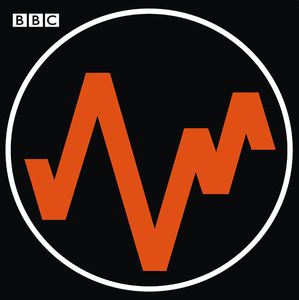

What a fantastic website – great work on putting it all together! I think we must be kindred spirits. Although afraid I hold my hands up as being one of the people who have been guilty of misidentifying the Mike Harding who put together this LP in print when I wrote an article for ‘Record Collector’ magazine on collecting the EC 7″s a few years back… https://recordcollectormag.com/articles/joy-sfx
Hello, thank you, and yes, we do seem to share some common ground!
The Mike Harding Misidentification is very common, as is the even more confusing Roy Tempest, which even on the BBC Music website article about BBC Records initially got wrong – although it has been updated now too correct that.
https://www.bbc.co.uk/music/articles/0d86745c-fa0c-4150-af0d-d6ea9ab85f31
Also – re. your page on Vol 28 Comedy Sound Effects, I think I can fill in the majority of the gaps for you there as to where the remaining effects you hadn’t been able to trace have been sourced from – but there doesn’t seem to be the option to comment on that particular page?
That’s because that one is a page not a post. I think I’m trying to do some more chatty stuff in eth posts and more permamnent documentation of the label stuff in pages. I’m all ears on these gap though. Do tell!
Hello, I did post a reply on here a week or two back re. the sources of the comedy sounds but I wasn’t entirely convinced it had posted properly – I know you need to approve comments but assume you would have done that by now if it had come through so maybe it didn’t work properly – do you have a length limit to comments? – it was quite the mini-essay…
Hello Richard, and yes I got it all and replied, on 15th Oct. Must be something screwy with updates etc. And I do miss some comments